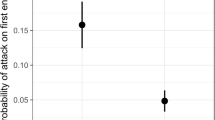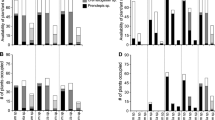Abstract
Species must balance effective competition with avoidance of mortality imposed by predators or parasites to coexist within a local ecological community. Attributes of the habitat in which species interact, such as structural complexity, have the potential to affect how species balance competition and mortality by providing refuge from predators or parasites. Disturbance events such as fire can drastically alter habitat complexity and may be important modifiers of species interactions in communities. This study investigates whether the presence of habitat complexity in the form of leaf litter can alter interactions between the behaviorally dominant host ants Pheidole diversipilosa and Pheidole bicarinata, their respective specialist dipteran parasitoids (Phoridae: Apocephalus sp. 8 and Apocephalus sp. 25) and a single species of ant competitor (Dorymyrmex insanus). We used a factorial design to manipulate competition (presence/absence of competitors), mortality risk (presence/absence of parasitoids) and habitat complexity (presence/absence of leaf litter). Parasitoid presence reduced soldier caste foraging, but refuge from habitat complexity allowed increased soldier foraging in comparison to treatments in which no refuge was available. Variation in soldier foraging behavior correlated strongly with foraging success, a proxy for colony fitness. Habitat complexity allowed both host species to balance competitive success with mortality avoidance. The effect of fire on habitat complexity was also studied, and demonstrated that the immediate negative impact of fire on habitat complexity can persist for multiple years. Our findings indicate that habitat complexity can increase dominant host competitive success even in the presence of parasitoids, which may have consequences for coexistence of subordinate competitors and community diversity in general.




Similar content being viewed by others
References
Alonzo SH (2002) State-dependent habitat selection games between predators and prey: the importance of behavioral interactions and expected lifetime reproductive success. Evol Ecol Res 4:759–778
Andersen AN (1985) Immediate effects of fire on ants in the semi-arid mallee region of north-western Victoria. J Ecol 10:25–30
Andow DA, Prokrym DR (1990) Plant structural complexity and host-finding by a parasitoid. Oecologia 82:162–165
Bell SS, McCoy ED, Mushinsky HR (1991) Habitat structure: the physical arrangement of objects in space. Chapman and Hall, London
Bestelmeyer BT, Schooley RL (1999) The ants of the southern Sonoran desert: community structure and the role of trees. Biodiversity Conserv 8:643–657
Cerdá X, Retana J, Cros S (1997). Thermal disruption of transitive hierarchies in Mediterranean ant communities. J Anim Ecol 66:363–374
Chandler C, Cheney P, Thomas P, Trabaud L, Williams D (1983) Fire in forestry vol 1. Forest fire behavior and effects. Wiley, New York
Chase JM, Abrams PA, Grover JP, Diehl S, Chesson P, Holt RD, Richards SA, Nisbet RM, Case TJ (2002) The interaction between predation and competition: a review and synthesis. Ecol Lett 5:302–315
Clark TL, Messina FJ (1998) Plant architecture and the foraging success of ladybird beetles attacking the Russian wheat aphid. Entomol Exp Appl 86:153–161
Davidson DW (1977) Species diversity and community organization in desert seed-eating ants. Ecology 58:711–724
Davidson DW, Inouye RS, Brown JH (1984) Granivory in a desert ecosystem: experimental evidence for indirect facilitation of ants by rodents. Ecology 65:1780–1786
Downes BL, Lake PS, Schreiber ES, Glaister A (1998) Habitat structure and regulation of local species-diversity in a stony, upland stream. Ecol Monogr 68:237–257
Ellner SP, et al. (2001) Habitat structure and population persistence in and experimental community. Nature 412:538–543
Feener DH Jr (1981) Competition between ant species: outcome controlled by parasitic flies. Science 214:815–817
Feener DH Jr (2000) Is the assembly of ant communities mediated by parasitoids? Oikos 90:79–88
Finke DL, Denno RF (2002) Intraguild predation diminished in complex-structured vegetation: implications for prey suppression. Ecology 83:643–652
Fletcher WJ, Underwood AJ (1987) Interspecific competition among subtidal limpets-effect of substratum heterogeneity. Ecology 68:387–400
Fraser DF, Huntingford FA (1986) Feeding and avoiding predation hazard: the behavioral response of the prey. Ethology 73:56–68
Gosselin LA, Bourget E (1989) Individual performance in relation to structural heterogeneity: the influence of substratum topography on an intertidal predator, Thais lapillus. J Anim Ecol 58:287–304
Hansen RA (2000) Effects of habitat complexity and composition on a diverse litter microarthropod assemblage. Ecology 81:1120–1132
Heck KL, Wetstone GS (1977) Habitat complexity and invertebrate species richness and abundance in tropical seagrass meadows. J Biogeogr 4:135–142
Hoddle MS (2003) The effect of prey species and environmental complexity on the functional response of Franklinothrips orizabensis: a test of the fractal foraging model. Ecol Entomol 28:309–318
Hölldobler B, Wilson EO (1990) The ants. Belknap Press of Harvard University Press, Cambridge, Mass.
Holway DA (1999) Competitive mechanisms underlying the displacement of native ants by the invasive Argentine ant. Ecology 80:238–251
Kirby KN (1993) Advance data analysis with SYSTAT. Van Nostrand Reinhold, New York
Kneitel JM, Chase JM (2004) Trade-offs in community ecology: linking spatial scales and species coexistence. Ecol Lett 7:69–80
LeBrun EG (2003) When to lose your head: ant-phorid fly interactions, community level impacts and evolutionary significance. Dissertation. Graduate Degree Program in Ecology and Evolution, University of Utah, Utah
LeBrun EG (2005) Who is the top dog in ant communities? Resources, parasitoids, and multiple competitive hierarchies. Oecologia 142:643–652
LeBrun EG, Feener DH Jr (2002) Linked indirect effects in ant-phorid interactions: impacts on ant assemblage structure. Oecologia 133:599–607
Lima SL, Dill LM (1990) Behavioral decisions made under the risk of predation: a review and prospectus. Can J Zool 68:619–640
MacArthur RH, MacArthur JW (1961) On bird species diversity. Ecology 42:594–598
Mehdiabadi NJ, Gilbert LE (2002) Colony-level impacts of parasitoid flies on fire ants. Proc R Soc Lond [Biol] 269:1695–1699
Morrison LW (1997) Oviposition behavior and development of Pseudacteon flies (Diptera: Phoridae), parasitoids of Solenopsis fire ants (Hymenoptera: Formicidae). Environ Entomol 26:716–724
Morrison LW (1999) Indirect effects of phorid fly parasitoids on the mechanisms of interspecific competition among ants. Oecologia 113:122
Morrison LW, Porter SD (2005) Testing for population-level impacts of introduced Pseudacteon tricuspis flies, phorid parasitoids of Solenopsis invicta fire ants. Biol Control 33:9–19
Morrison WL, Kawazoe AE, Guerra R, Gilbert LE (2000) Ecological interactions of Pseudacteon parasitoids and Solenopsis ant hosts: environmental correlates of activity and effects on competitive hierarchies. Ecol Entomol 25:433–444
Norton AP, English Loeb G, Belden E (2001) Host plant manipulation of natural enemies: leaf domatia protect beneficial mites from insect predators. Oecologia 126:535–542
O’Connor NA (1991) The effects of habitat complexity on the macroinvertebrates colonizing wood substrates in a lowland stream. Oecologia 85:504–512
Orr MR, Seike SH, Benson WW, Gilbert LE (1995) Flies suppress fire ants. Nature 26:292
Orr MR, Dahlsten DL, Benson WW (2003) Ecological interactions among ants in the genus Linepithema, their phorid parasitoids, and ant competitors. Ecol Entomol 28:203–210
Orth RJ, Heck KL et al (1984) Faunal communities in seagrass beds: a review of the influence of plant structure and prey characteristics on predator–prey relationships. Estuaries 7A:339–350
Pianka ER (1966) Convexity, desert lizards, and spatial heterogeneity. Ecology 47:1055–1059
Ripple WJ, Beschta RL (2004) Wolves and the ecology of fear: can predation risk structure ecosystems. BioScience 54:755–766
Rothley KD, Schmidtz OJ, Cohon JL (1997) Foraging to balance conflicting demands: novel insights from grasshoppers under predation risk. Behav Ecol 8:551–559
Ryti RT, Case TJ (1988) Field experiments on desert ants: testing for competition between ants. Ecology 69:1993–2003
Schoener TW (1974) Resource partitioning in ecological communities. Science 185:27–39
Smith DRR (1985) Habitat use by colonies of Philoponella republicanna (Araneae, Uroboridae) J Arachnol 13:363–373
Sokal and Rohlf (1995) Biometry. Freeman, New York
Swetnam TW, Baisan CH (1996) Fire histories of montane forests in the Madrean Borderlands. In: Folliott PF et al. (technical coordinators) Effects of fire on Madrean Province Ecosystems. Proceedings. USDA Forest Service general technical report RM-GTR-289, pp 15–36
Swetnam TW, Betancourt JL (1998) Mesoscale disturbance and ecological response to decadal climate variability in the American Southwest. J Climate 11:3128–3147
SYSTAT, Inc. (2004) SYSTAT version 11. Richmond, CA
Tilman D (1994) Competition and biodiversity in spatially structured habitats. Ecology 75:2–16
Werner EE, Peacor SD (2003) A review of trait-mediated indirect interactions in ecological communities. Ecology 84:1083–1100
Whitford WG, Forbes GS, Kerley GI (1995) Diversity, spatial variability, and functional roles of invertebrates in desert grassland ecosystems. In: McClaran MP, Van Devender TR (eds) The desert grassland. University of Arizona Press, Tucson, Ariz.
Williams CB (1943) Area and the number of species. Nature 152:264–267
Wisdom WA, Whitford WG (1981) Effects of vegetation change on ant communities of arid rangelands. Environ Entomol 10:893–897
Acknowledgements
Ed LeBrun provided crucial training and input at the inception of this study. This manuscript benefited substantially from the comments of two anonymous reviewers and Craig Osenberg. Jessica Pearce, Philipp Wiescher, Roxana Arauco, Ryan Bixenmann, Arne Hultquist and Martin Moyano also provided useful comments on the manuscript. Thanks to Stefan Cover for identifying host ants and the Sperry lab at the University of Utah for use of their drying ovens. This study would not have been possible without the assistance of Joe and Valer Austin, the facilities of the Southwestern Research Station and the help of Robert Minckely. Mary Wilkinson provided much needed support. We would like to acknowledge funding from the American Museum of Natural History Theodore Roosevelt Memorial Fund, Sigma Xi, the University of Utah Biology Department and the Associated Students of the University of Utah. A NSF Dissertation Improvement Grant to E. B. Wilkinson partially funded this work. D. H. Feener Jr wishes to acknowledge support from NSF grant DEB 03-16524. These experiments comply with the current laws of the countries in which they were performed.
Author information
Authors and Affiliations
Corresponding author
Additional information
Communicated by Andrew Gonzales.
Rights and permissions
About this article
Cite this article
Wilkinson, E.B., Feener , D.H. Habitat complexity modifies ant–parasitoid interactions: implications for community dynamics and the role of disturbance. Oecologia 152, 151–161 (2007). https://doi.org/10.1007/s00442-006-0634-6
Received:
Accepted:
Published:
Issue Date:
DOI: https://doi.org/10.1007/s00442-006-0634-6




